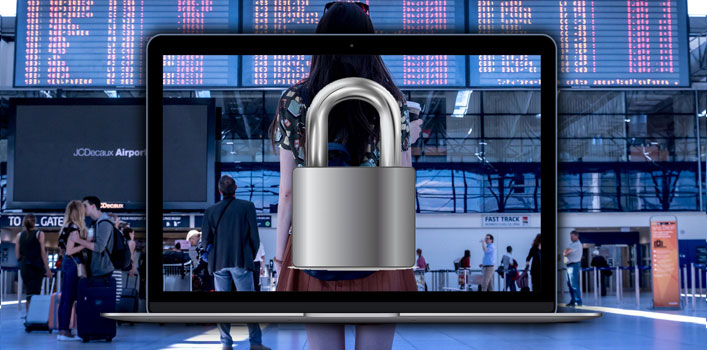The Holidays are now upon us and many will traveling. Whether it is to visit relatives, a secondary corporate location or client site across the country, travel may be part of your plans. In this day and age and considering the Internet Of Things and BYOD (Bring Your Own Device), the practice of taking extra measures to ensure security for your devices has become not only commonplace, but a necessity.
So in this blog installment we endeavor to provide 9 ways to help protect your data and your privacy when traveling, regardless of purpose.
1) Leave devices behind if you do not need them
The simplest and most effective way of protecting your devices is to not bring them. These days, if flying is part of your travel plans, airplanes are chock-full of entertainment including seat-back screens with videos and games, headsets for in-seat audio experiences, etc.
If having the ability to reached is the only real need when traveling, consider purchasing a pre-paid phone. You won’t have your video streaming available or your games to play, but you will have the ability to stay in touch with loved ones or colleagues in a secure manner.
2) Use a USB wifi HotSpot
Logging into public WiFi connections has a number of inherent risks. While using a USB Wifi hotspot does not mitigate every conceivable threat, it does provide a measure of safety and peace of mind.
Many wireless carriers allow connection to your portable device as a hot spot. or you can purchase a “dongle” for as little as $8 (plus access plan) to utilize a private wifi connection.
3) Avoid using Computers available to the public
A major threat to personal and other data is the use of public devices and computers. There may be any type of malware, key logger or other threat that is present on these computers and there is no real way for you to know. Regardless of the security level of the maintenance on these machines.
Best practices dictate, if you are compelled to use a public computer, that you not log into social media, email or financial accounts. This may be difficult because the main reasons to access computers in the first place may be those very scenarios.
4) Traveling Abroad? Back up and wipe your data!
Many countries, including the United States, reserve the right to search your computers and devices when entering or returning to a country. And this security measure is on the increase.
There is no guarantee that your data will not be cloned by less than scrupulous personnel. To protect your sensitive data, you can back up your data to a cloud storage solution, then wipe your hard drive clean. This may seem a bit extreme to some but when considering the alternative, “a ounce of prevention is worth a pound of cure”.
Back up! Back up! Back up!
5) Use a LiveUSB or LiveCD
Another alternative into carry a USB drive with a portable Linux operating system on it. This allows you to plug and play using the USB completely independent of the system you are on. You will not need to log into the machine you are on and continue working privately using the files on your flash drive.
6) HTTPS and VPN
Accessing any internet at all should be done using HTTPS – https will encrypt all data served to the browser. This is a safe way to safeguard the data you are viewing online.
A VPN subscription uses a remote server and IP address and encrypts everything you are doing on that device. Consider a VPN subscription to provide you safety and security while traveling as this can thwart even the trickiest of cyberthreats.
7) Two-Factor Authentication
You are probably already using two-factor authentication (commonly referred to as 2FA), and may not be aware of it. When you purchase something with a credit card, you are asked not only for the card number, but also the CVV number, typically found on the back of the credit card. This method has now become widespread and can now help protect your social media accounts, email accounts and more. Instead of simply logging into a particular portal (log in screen), once the login has been submitted, you will then be required to enter a separate code that has been pushed (sent) to your mobile device. This provides a second level of security in order to log into any of your sensitive accounts. Hence the name, two-factor authentication.
1FA provides some security because you have to enter a unique password, but we have all seen how password security has been an issue for some time due to the influx of
8) Use the Latest Operating System
Many cybercriminals find easy targets in those who, for whatever reason, have not updated their operating systems and security software to the latest versions. Windows and Apple, for example, are constantly pushing updates to their systems. And many of these updates are not simply updates to nifty operating system features, but are more security-based in order to thwart the efforts of cybercriminals, Spam-ware and Ransomware.
9) Back Up! Back Up! Back Up!
Did we mention backing up your system and data? Did we mention the benefits of backup up to a cloud hosting solution? Well it is worth repeating! Worst case scenario, if you are, in fact, a victim of cybercrime, you will know you have your latest data backed up to a secure and remote location for near instant remediation.
There are many ways to help ensure your privacy and security when it comes to traveling and your data. This list is but a handful of best practices and conventional wisdom. Should you wish to discuss this or find additional methods, please feel free to contact one of our many qualified technical security gurus and we will be happy to help.
Happy Holidays and Safe Travels!

